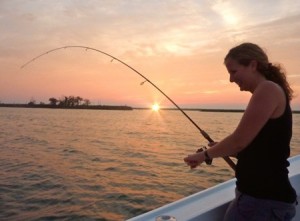rockfish
 I’ve collected a number of sunset photos over the past eight or nine days. As water temperatures begin to fall, stripers are moving into shallower water where they can find cover while chasing bait. I’ve been setting our drifts over humps in the 4 to 5 foot range in the flats around Kent, Poplar, and Tighlman Islands. While almost any kind of top-water lure will work, I prefer Lonely Anglers, Stillwater SmackIts, and Heddon Super Spooks. The fish can bite anytime, but they always turn on right about the time the sun hits the western horizon. There have been a few birds working in the shallows, but some of the most successful trips have just been blind-casting over structure. Any area where the bottom comes up a foot or more over the surrounding flat can hold fish. Aquatic grass is a plus. Good water quality is essential. So is flowing current. That’s been somewhat hard to come by lately. Hurricane Earl has made its way past the mouth of the Chesapeake and up the Atlantic Seaboard with very little impact on our region except for a disruption in the normal tidal patterns. I’ve been compensating by Read More!
I’ve collected a number of sunset photos over the past eight or nine days. As water temperatures begin to fall, stripers are moving into shallower water where they can find cover while chasing bait. I’ve been setting our drifts over humps in the 4 to 5 foot range in the flats around Kent, Poplar, and Tighlman Islands. While almost any kind of top-water lure will work, I prefer Lonely Anglers, Stillwater SmackIts, and Heddon Super Spooks. The fish can bite anytime, but they always turn on right about the time the sun hits the western horizon. There have been a few birds working in the shallows, but some of the most successful trips have just been blind-casting over structure. Any area where the bottom comes up a foot or more over the surrounding flat can hold fish. Aquatic grass is a plus. Good water quality is essential. So is flowing current. That’s been somewhat hard to come by lately. Hurricane Earl has made its way past the mouth of the Chesapeake and up the Atlantic Seaboard with very little impact on our region except for a disruption in the normal tidal patterns. I’ve been compensating by Read More!
 Memorial Day Weekend marks the start of summer for many Chesapeake boaters, but it means a slow-down in fishing for those of us who have been out all along. All the boat traffic on the Bay can put the fish in hiding, but it’s a tough time of year no matter what. Many anglers blame the slow fishing on may worms. May worms, also called clam worms, live on the shell bottoms of the bay and swarm during late May. The reddish worms can be up to 5 inches long and develop small swimming fins to propel them up from the bottom when they mate during the dark of the moon. I guess they are a tasty treat for rockfish. Some fish you catch this time of year area actually yellow or red tinged because of all the may worm gorging. Read More!
Memorial Day Weekend marks the start of summer for many Chesapeake boaters, but it means a slow-down in fishing for those of us who have been out all along. All the boat traffic on the Bay can put the fish in hiding, but it’s a tough time of year no matter what. Many anglers blame the slow fishing on may worms. May worms, also called clam worms, live on the shell bottoms of the bay and swarm during late May. The reddish worms can be up to 5 inches long and develop small swimming fins to propel them up from the bottom when they mate during the dark of the moon. I guess they are a tasty treat for rockfish. Some fish you catch this time of year area actually yellow or red tinged because of all the may worm gorging. Read More!
 Have you ever wondered why fish seem to turn on and off at different times during the day? If you’re like me you’ve probably gone for hours without catching a fish, hardly even getting a strike. Then, click, just like turning on a light switch every cast results in a fish. Fishermen refer to this phenomenon as “the bite,” as in, “The bite turned-on about 3:00 PM and off at dark.” Read More!
Have you ever wondered why fish seem to turn on and off at different times during the day? If you’re like me you’ve probably gone for hours without catching a fish, hardly even getting a strike. Then, click, just like turning on a light switch every cast results in a fish. Fishermen refer to this phenomenon as “the bite,” as in, “The bite turned-on about 3:00 PM and off at dark.” Read More!


